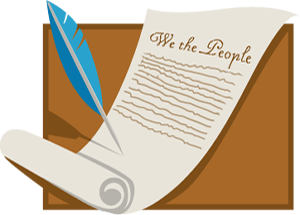On July 4, 1776, the Declaration of Independence broke political ties between the colonists and the British government. Following this separation, delegates met at the Second Continental Congress to write a new constitution, known as the Articles of Confederation. Driven by fears of a strong central government, the Articles established a union of cooperation among the states. This political association carried the states successfully through war, but its limitations became more apparent as the United States began establishing its seat as a new nation among the reigning European powers.
In order to rectify the problems that emerged under the Articles of Confederation, representatives called for a meeting in Philadelphia to recommend revisions. For four months (May to September, 1787), George Washington presided over the debates at the convention, where delegates offered competing ideas for the establishment of a centralized government whose power could be limited, and where individual rights were not surrendered to a superior authority. Through a series of proposals, delegates began considering the establishment of three branches of government, consisting of a legislative body, executive leader, and a national judiciary. At the conclusion of the debates, these new ideas resulted in the writing of an entirely new U.S. Constitution that would take the place of the Articles of Confederation as the supreme law of the land.
Thumbnail
